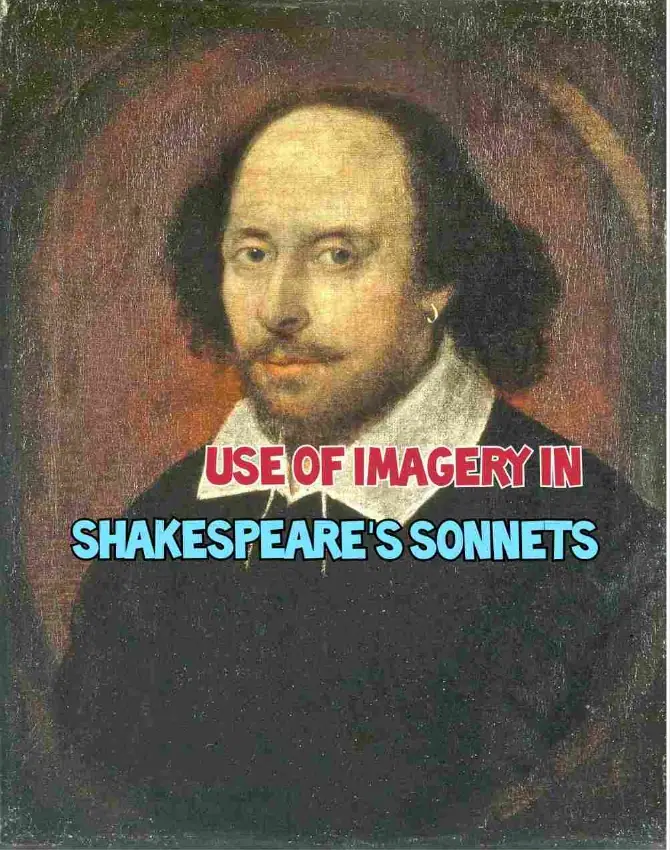Use of Imagery in Shakespeare’s Sonnets
Shakespeare is the greatest sonneteer in English literature not only of the Elizabethan Age but of all ages. In all, he wrote one hundred and fifty-four sonnets.
Of these, sonnets numbering from one to one hundred and twenty-six, have been addressed to his friend and patron, perhaps Earl of Southampton, sonnets numbering one hundred and twenty-seven to one hundred and fifty-two, have been addressed to a dark lady (perhaps Mary Fitton) and sonnets numbering one hundred and fifty-three to one hundred and fifty-four have been addressed to Cupid, the God of love.
Now in all these sonnets, we notice excellent imageries which the poet has used to express his thought clearly about love and beauty.
In “A Mid Summer Night’s Dream”, Shakespeare has nicely observed,
” The poet’s eye in a fine frenzy rolling,
Doth glance from Heaven to Earth, from Earth to Heaven;
And as imagination bodies forth
The forms of things unknown, the poet’s pen,
Turns them to shapes and gives to airy nothing
A local habitation and a name.”
This observation is perfectly true in case of Shakespeare’s own poetry. With his sublime imagination, Shakespeare can see from Heaven to Earth, nay even the whole Universe and gives shapes to things which were non-existent on earth, with his unparalleled imagination. In his sonnets, Shakespeare has created apt imageries spontaneously one after another to clarify his thoughts.
In the sonnet “Shall I Compare Thee To A Summer’s Day” (sonnet no XViii) the theme is his fervent love for his beautiful young friend whom he wants to immortalise through his verse. In the sonnet, Shakespeare describes the charming beauty of his youthful friend taking imageries from the world of nature.
First of all, he has compared his friend’s beauty to a loving ‘summer’s day’. But in the same breath he points out that his friend is far ‘more lively and more temperate’ than a sweet summer’s day. In the next imagery he compares his friend to “the darling buds of May.”
As a bud of May is fresh, lively and beautiful so is his friend. In the next imagery the poet compares the fine golden complexion of his friend with the golden complexion of the rising sun. In all these imageries, we see Shakespeare has taken resort to Nature to describe human beauty. All these prove that in Shakespeare’s concept Man and Nature are inseparable in creation.
But Shakespeare expresses the central truth that an object however beautiful it may be, it must decline. But he will immortalise his friend’s beauty and virtue in his immortal poems. The poet says, using another imagery,
“But thy eternal summer shall not fade ,
Nor lose possession of that fair thou ow’st,
Nor shall death brag thou wand’rest in his shade,
When in eternal lines to time thou grow’st.
So long as men can breath, or eyes can see,
So long lives this, and this gives life to the.”
In the next sonnet, “That Time of Year Thou Mayst in Me Behold” (sonnet no LXXiii), the poet plaintively anticipates the decay of his vigour and manhood and consequence death. He sadly imagines the time when he will cease to have his manly strength and power. To describe this, the poet uses imagery instantly,
“That time of year thou mayst in me behold
When yellow leaves, or none, or few do hang
Upon those boughs which shake against the cold,
Bare ruin’d choirs, where late the sweet birds sang.”
He also says that his friend will see in him the twilight of such a day as fades in the West after sunset and which black night, ‘death’s second self’ must seal up all in rest. This is also an imagery to emphasize the poet’s decaying state.
In another imagery, the poet fancies ruefully the state of growing dusk and the dying heart in his own body. However, he thinks that his friend’s love will grow more and more for him thinking of his transient life on earth.
In another sonnet, “Let Me Not to the Marriage of True Minds” (sonnet no CXVi), Shakespeare uses a number of apt imageries to describe the nature of true love between two sincere souls. True love never changes with the alteration of time, place, circumstances etc. Using imageries Shakespeare observes,
“Let me not to the marriage of true minds,
Admit impediments, love is not love
Which alters when it alteration finds,
Or bends with the remover to remove.”
Using another imagery, Shakespeare further comments on true love.
“It is an ever-fixed mark.
That looks on tempests, and is never shaken.”
Next Shakespeare uses the imagery of the ever-fixed pole star to describe the ever constant true love of two genuine hearts. Then he uses the imagery of Time and Love. Time is a mower which cuts off “rosy lips and cheeks” of men and women with his bending sickle but it can never destroy true love.
You May Like To Read More:
